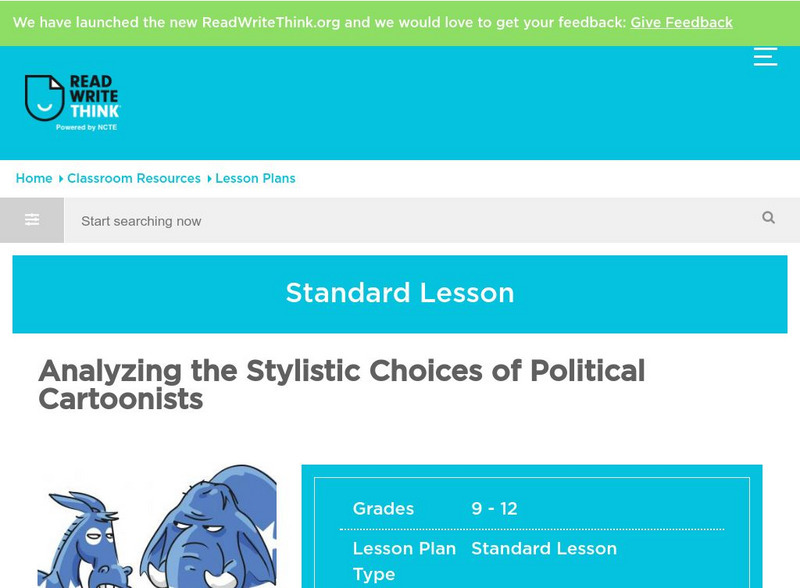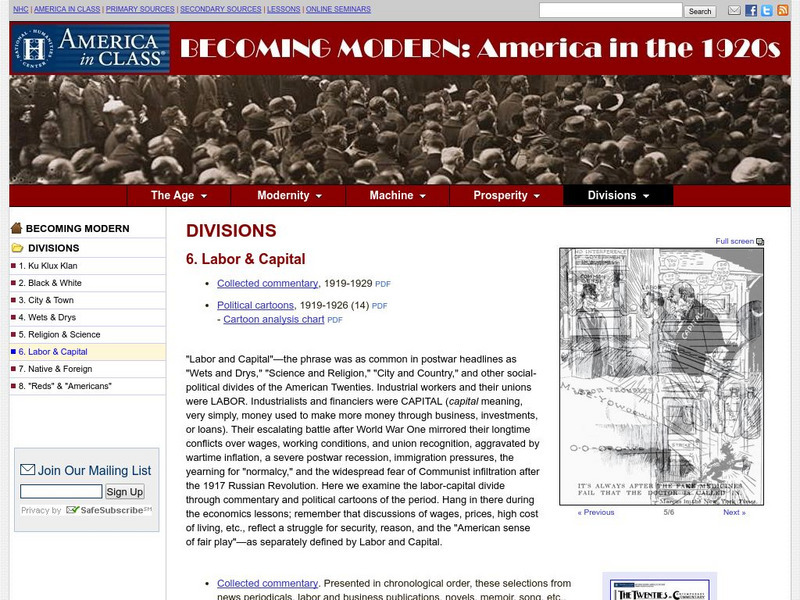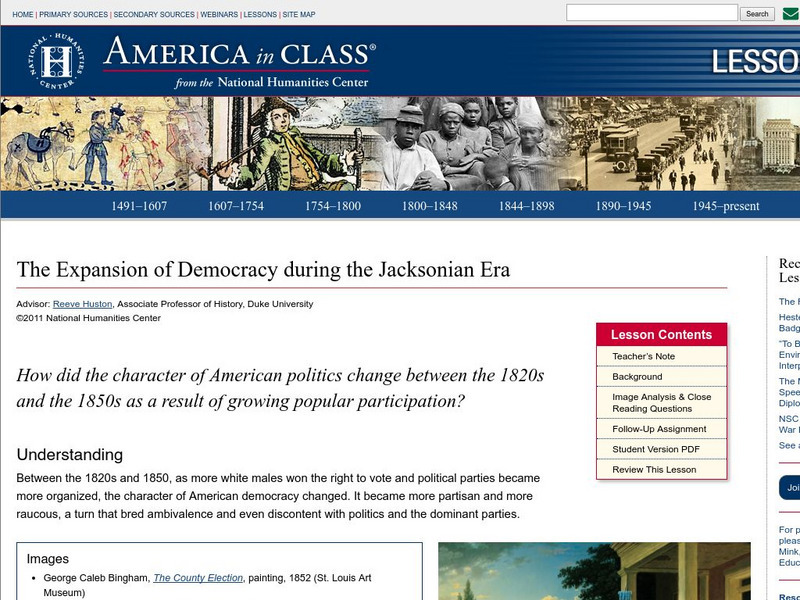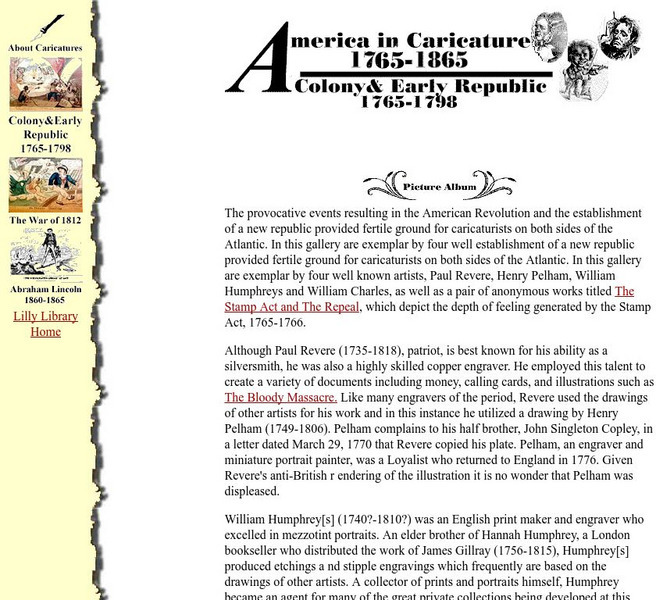Curated OER
The Ratification Debate
Eighth graders investigate the debate in order to understand the Ratification in context of the period of history being studied. They read text answer questions through identifying the differences between Federalists and Antifederalists.
Choices Program, Brown University
Choices: u.s. Policy in the Middle East: Analyzing Political Cartoons
Multi-media resources including video, PowerPoint, articles and maps from which students explore current issues in the Middle East and their relation to U.S. policy and interpret political cartoons on Middle East politics.
South Carolina Educational Television
Know It All: Analyzing Political Cartoons
Fifth graders will learn different strategies that will help them to analyze the overall meaning of a political cartoon. The cartoons are focused on the Reconstruction Era. They will then design their own political cartoon that a peer...
Choices Program, Brown University
Choices: The United States in Afghanistan: Analyzing Political Cartoons
Using videos, handouts, and online resources, learners explore viewpoints on the U.S. presence in Afghanistan, interpret political cartoons and place them in the context of a political discussion about Afghanistan, and identify the...
Library of Congress
Loc: Lesson Plans: Political Cartoons: Finding Point of View
Lesson plan on analyzing a political cartoon that satirizes the Stamp Act.
ReadWriteThink
Read Write Think: Analyzing the Stylistic Choices of Political Cartoonists
Contains plans for four to five 50-minute lessons about analyzing political cartoons. In addition to student objectives and standards, these instructional plans contains links to PDF handouts and links to sites used in the lessons as...
John F. Kennedy Center
The Kennedy Center: Drawing Political Cartoons: How Do They Convey Messages About Current Events?
In this 9-12 lesson, students will analyze cartoon drawings to create an original political cartoon based on current events. Students will apply both factual knowledge and interpretive skills to determine the values, conflicts, and...
ReadWriteThink
Read Write Think: Purpose and Meaning of Political Cartoons
This lesson plan explores the political and social influence of political cartoons. Included in the lesson plan is an overview, practice, objectives, resources, preparation, and more.
Alabama Learning Exchange
Alex: Political Cartoon Analysis
Students will review and discuss how to evaluate the symbols and related meanings of political cartoons. The project will involve analyzing a current political cartoon, determining its meaning, and presenting the information to the class.
US National Archives
National Archives: Representing Congress: Clifford Berryman's Political Cartoons
Political cartoons have informed the public and sparked debate throughout history. This ebook contains political cartoons pertaining to Congress. Students will understand the powers and responsibilities of Congress by analyzing these...
PBS
Pbs Teachers: Analyzing Election Cartoons (Lesson Plan)
A lesson that helps learners identify symbols and caricature in political cartoons. Students will analyze how political cartoons portray messages, opinions, and points of view and will then compare them with written editorials.
Library of Congress
Loc: Oliphant's Anthem
A Library of Congress online exhibition of Pulitzer Prize-winning political cartoonist, Pat Oliphant. View over sixty cartoons and see why he is known as one of the most influential editorial cartoonists in America.
Khan Academy
Khan Academy: Ap Us History Unit: Unit: Period 7: 1890 1945: Quiz
The study resource from Khan Academy provides a video lesson over Period 7: 1890-1945 in American History. This self-assessment covers context for The Spanish-American War and the debate about imperialism. This resource is designed as a...
PBS
Pbs News Hour Extra: The Impact of Egypt's Political Revolution
Lesson plan provides a summary of the impact of the Egyptian revolution of 2011 on other countries in North Africa and the Middle East. Cartoons are provided that comment on the emergence of democracy and the importance of oil and...
Newspapers in Education
Ni Eonline: Cartoons for the Classroom: Cartoon Analysis Worksheet [Pdf]
Newspapers in Education and the Association of American Editorial Cartoonists developed this activity as a classroom handout to aid lessons in dissecting the visual and verbal messages of political cartoons.
National Humanities Center
National Humanities Center: America in Class: America in the 1920s: Labor & Capital
The National Humanities Center presents collections of primary resources compatible with the Common Core State Standards - historical documents, literary texts, and works of art - thematically organized with notes and discussion...
PBS
Pbs Learning Media: Anti Chinese Movement of the 1800s
Analyze primary sources in the media gallery and create an illustrated poem to learn how and why Chinese Americans were seen as threats to American society during the 1800s. This Anti-Chinese movement was one of the earlier incidents of...
Stanford University
Sheg: Document Based History: Reading Like a Historian: Thomas Nast
[Free Registration/Login Required] Learners read primary source documents to solve a problem surrounding a historical question. This document-based inquiry lesson allows students to analyze two cartoons drawn by Thomas Nast, and to chart...
National Humanities Center
National Humanities Center: America in Class: Expansion of Democracy During the Jacksonian Era
Lesson where students explore the emergence of the American system of democracy and political parties between 1820 and 1850. Using paintings by George Caleb Bingham and Richard Caton Woodville, and a political cartoon depicting the...
Yad Vashem, The World Holocaust Remembrance Center
Yad Vashem: Germany's Sculptor
Hitler used art and images as propaganda during WWII. Students will use these primary sources to recognize the manipulation used by the Nazi regime. They will learn how to analyze and recognize the propaganda techniques used by...
Indiana University
Indiana University: Colony & Early Republic
This site from the Indiana University analyzes the role of political cartoons in early American history. Four artists, Paul Revere, Henry Pelham, Wm. Humphreys, and Wm. Charles are highlighted.
Georgia Department of Education
Ga Virtual Learning: Ap Literature & Composition: Satire and Humor
This unit focuses on satire and humor; it defines satire as a literary device used to expose follies, vices, and hypocrites to bring about change. It includes links to Gullivers Travels and Modest Proposal by Jonathan Swift, "The Rape of...
US National Archives
National Archives: Prohibition and Its Consequences
Was prohibition necessary to protect family values or was it an over-reach by the government? Learners will debate this question while analyzing documents from this era. Documents include political cartoon, photos, letters from citizens,...
Stanford University
Sheg: Document Based History: Reading Like a Historian: American Imperialism
[Free Registration/Login Required] The American Imperialism Unit covers the Spanish-American War and the Philippine-American War. The lessons approach historical inquiry from different angles. One asks young scholars to consider...















